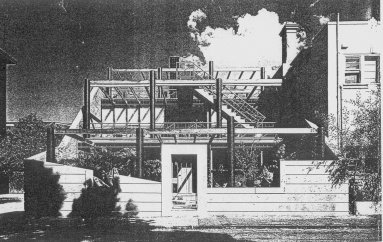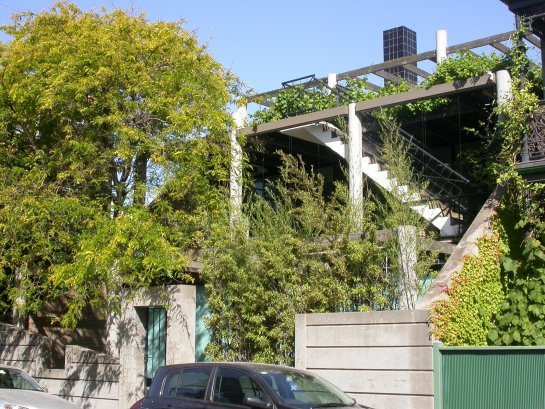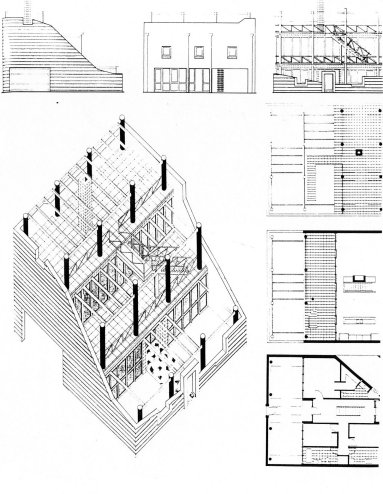|
|
|
Home | Introduction | Contents| Feedback | Map | Sources | Glossary |
|
13
Crigan House
The City of St Kilda’s Twentieth Century Architectural Study claims this house, built in 1988-89 and known locally after it’s architect as ‘the Allan Powell House’, to be ‘arguably the most distinctive and creative piece of domestic architecture to have been built in St Kilda in the 1980s’. I won’t disagree with that, but it doesn’t have much competition. No other 1980s ‘domestic building’ is mentioned in the Study. It was then not yet quite fashionable for relatively affluent, educated middle-class families to establish in St Kilda and the brave pioneers who did, snapped up, relatively cheaply, pleasant old houses with potential, and renovated them.
Crigan House, 1989
Allan Powell graduated in architecture at the
Since at least 1988, Allan Powell’s design
interventions in St Kilda have re-defined settings, within urban contexts, for
various aspects of St Kilda life. Powell’s evolving concern is for design
within the wide proscenium of context, and for the theatre of gesture and
effect, as they are contrived on the journey towards, into and through a space.
As he manipulates states of mind, sensibility and mood
during that experience, Powell is one of the most sensitive and perceptive
architects of his generation. Whether at Caffé
Maximus (7), in the same year as
It is interesting to speculate and compare not dissimilar concerns of much younger architect, Cassandra Fahey, at the Sam Newman house (22). Both combine Modernism within a Post-modernist shell. The different degrees of privacy and containment and of signification are perhaps more a product of their different times and Powell himself has since moved right along.
Allan Powell’s later major works outside St
Kilda include: RMIT University Building 94 at
The owners of
Crigan House, 2004 Allan Powell’s plan is actually quite rational, formal and indeed, symmetrical. He explains his intentions to ‘confuse the intellect and to force a reliance on the senses’. Like a deliberately designed ‘ruin’ in an eighteenth century picturesque English Landscape Garden, a rigorous three bays wide by four bays deep grid of structure (columns and pergola beams), with undifferentiated Miesian glazing, rises up out of the designed ruin of the external walls. It is like an open casket, ‘an arbitrary box’, surrounded by the urbanity of densely developed 1920s to 30s flats.
Whilst the vehicular entrance is ingeniously
angled to achieve easy access to the garage which is tucked in, as if under a
staircase, or grandstand, the three habitable levels step up overhead, allowing
each a terrace. The entire first floor is a living space, opening over the
terrace, for entertainment, with glimpses of the bay. Its north - west
orientation catches the full afternoon sun, throwing deep shadows, with an
exposed
Powell says that fine craftsmanship and detailing were not relevant, historicist references are very abstracted and the building is not intended to be visually resolved as a three dimensional composition. It’s uneasy and provocative, in confusing and shattering its container.
Powell is near to my age, we were a generation
of designers trained in the pure Bauhaus Modernism of the
Later, when it became available, Powell
himself acquired the adjoining late Victorian house at
The authors of St Kilda’s
Twentieth Century Architectural Study conclude that the design
response at
Powell’s later buildings, such as The Prince (16), are more refined and sophisticated in colour, surface and subtlety of sensation, but the design principles are never as complex in gesture and experience as here. Nor do they experience quite the same rich understanding of the particularity (indeed the phenomenology) of living in St Kilda.
Isometric view and plan of Crigan House, 1989
References Aardvark. Web site: http://aardvark.tce.rmit.edu.au/.
Evans, Doug,
Executive Editor. Aardvark.
A Guide to Contemporary
Peck, Robert., von Hartell, Trethowan. Henshall Hansen Associates. City of St Kilda Twentieth Century Architectural Study. Vol.3. 1992. (Unpaginated).
Powell, Allan.
‘Crigan House. Architect: Allan Powell’.
Architecture
Powell, Allan.
‘Forgotten Zones’.
In
Reed, Dimity. ‘New house in St Kilda. Allan Powell’. Belle. 92. April/May 1989. pp 84-89.
Venturi,
Robert. Complexity and Contradiction in Architecture.
The
‘Views,
projects, visions - the City of
|
|
St Kilda Historical Society Inc. © 2005 |



